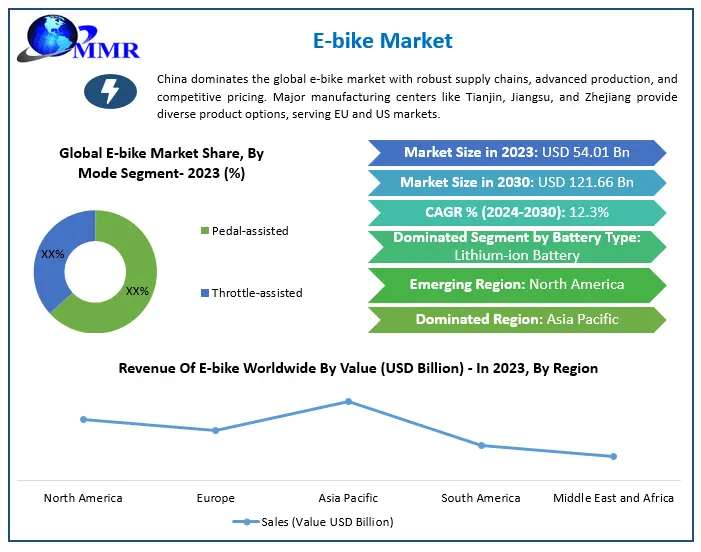E-bike Market Size Projected to Surpass USD 121.66 Bn by 2030 Amid Growing Consumer Adoption
E-Bike Market Soars with Innovations and Eco-Friendly Solutions
E-Bike Market Estimation & Definition
The global E-Bike Market Size, valued at USD 54.01 billion in 2023, is projected to experience substantial growth, reaching USD 121.66 billion by 2030. This market includes electric bicycles designed for commuting, recreation, fitness, and leisure, powered by integrated electric motors to assist pedaling. With various applications such as city commuting, mountain biking, and delivery services, e-bikes are redefining the transportation landscape, offering a cleaner, more sustainable alternative to traditional vehicles.
Gain access to valuable industry insights through the sample link: https://www.maximizemarketrese....arch.com/request-sam
E-Bike Market Growth Drivers & Opportunity
Several key drivers are propelling the growth of the e-bike market:
Sustainability Initiatives: As cities embrace eco-friendly transportation to combat congestion and pollution, e-bikes have become a cornerstone of sustainable urban mobility. Government incentives and infrastructure development, including bike lanes and charging stations, are further bolstering market adoption.
Environmental Awareness: Growing concerns over climate change and pollution are pushing consumers towards greener modes of transport. E-bikes, with their low emissions and energy efficiency, have become a preferred choice for environmentally conscious individuals, marking a shift in consumer behavior towards sustainable living.
Tourism & Recreation: E-bikes are increasingly seen as an exciting and accessible mode of exploration in tourism. Offering a unique way to explore destinations and challenging terrains, e-bikes align with the growing trend towards sustainable and experiential travel.
Technological Advancements: Innovations in battery technology, particularly the development of more powerful lithium-ion batteries, are improving the efficiency, affordability, and appeal of e-bikes. Additionally, smart apps, GPS integration, and foldable designs are transforming the rider experience and boosting demand for e-bikes.
E-Bike Segmentation Analysis
The market is segmented based on various factors:
Battery Type: The lithium-ion battery segment is dominant, with a market share of approximately 60% in 2023. These batteries are highly favored for their energy density, long lifespan, and affordability compared to alternatives like lead-acid batteries.
Product Type: E-Mountain Bikes (e-MTBs) have seen a surge in demand, driven by their versatility, durability, and suitability for both off-road adventures and urban commuting.
End-Use: E-bikes are used across multiple sectors, with growing interest in recreational, commuter, and delivery services.
Explore detailed data and insights by viewing the sample: https://www.maximizemarketrese....arch.com/request-sam
Country-Level Analysis
United States: As a global leader in e-bike adoption, the U.S. market benefits from strong infrastructure investments and a high level of consumer interest in sustainable transport. The government's push for reducing carbon footprints has paved the way for continued growth, particularly in urban areas.
Germany: Known for its strong automotive and cycling culture, Germany has become a key player in the European e-bike market. With robust government policies supporting green mobility and an increasing shift towards eco-friendly transportation, Germany is expected to remain a dominant force in the market.
Commutator Analysis
E-bike adoption for commuting is growing rapidly, driven by the advantages of reduced commuting costs, environmental benefits, and the appeal of bypassing urban traffic. E-bikes are especially favored in congested metropolitan areas where traditional commuting options are inefficient. This trend is supported by urban mobility solutions and the rise of shared e-bike services, which provide a flexible, cost-effective alternative to car ownership.


